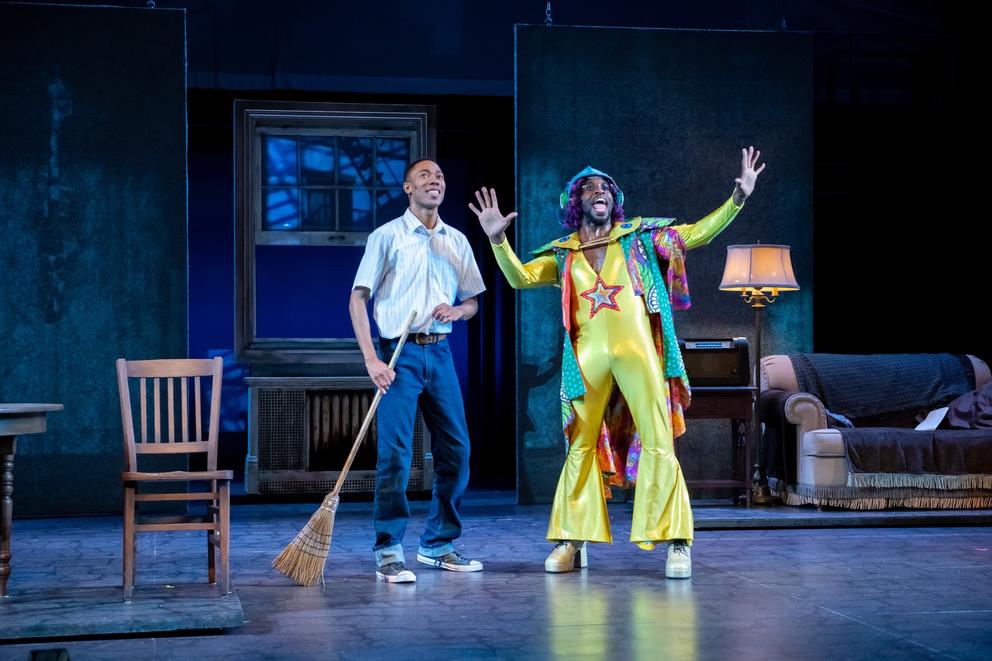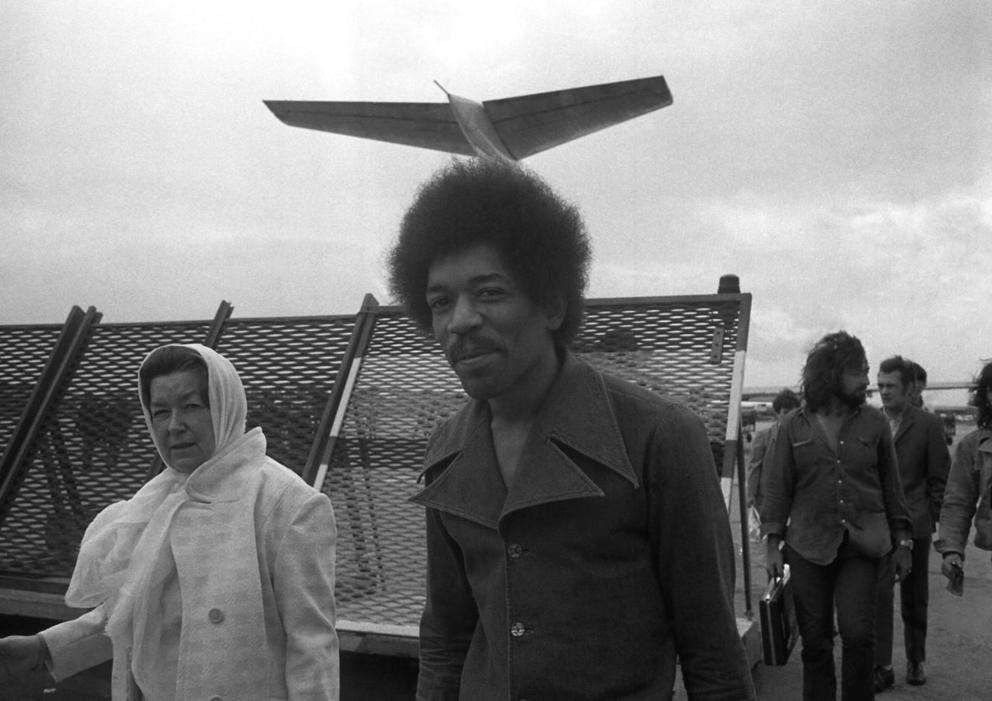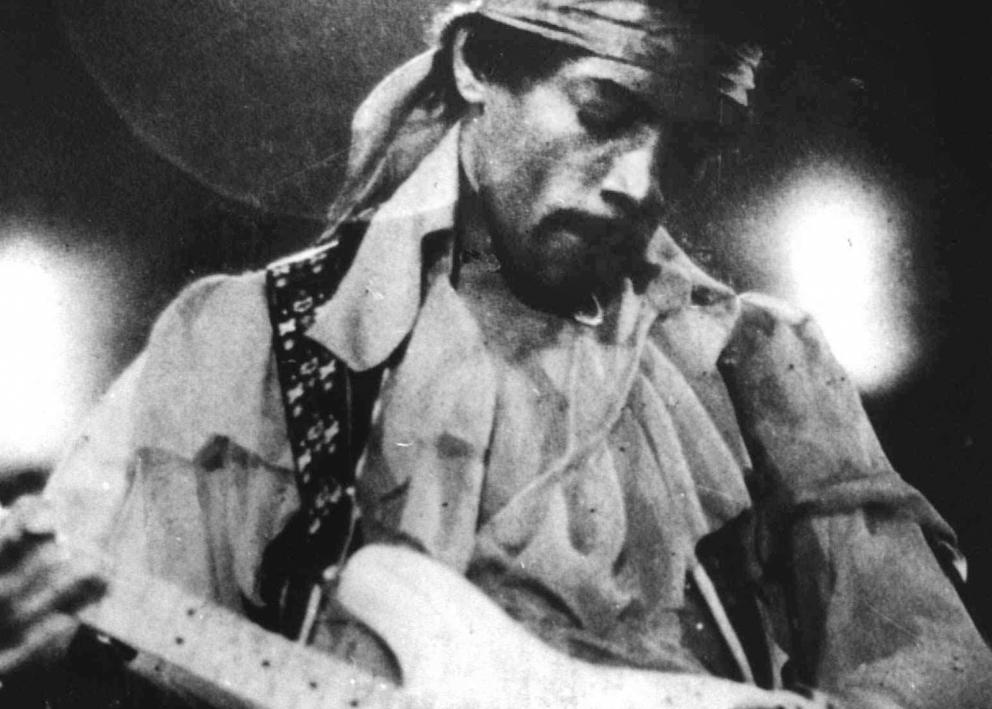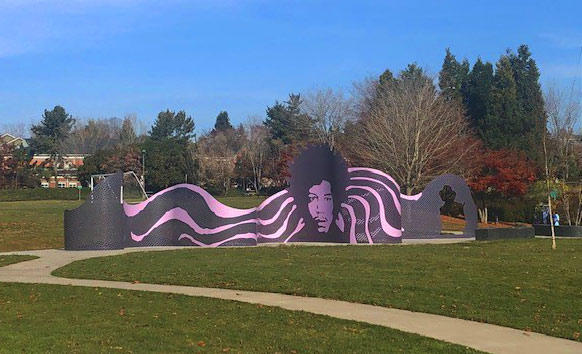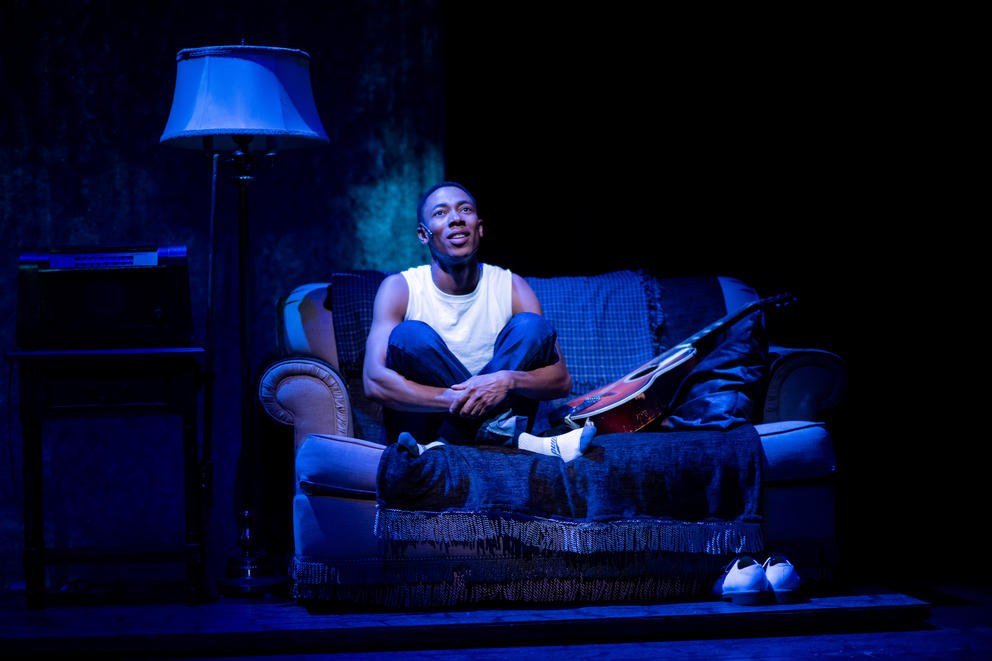With November marking the 80th anniversary of his birth, it’s an apt time to consider the legacy the rock legend has left in his hometown. Hendrix is without a doubt a revered rock icon, but his place in Seattle history — beyond a park named after him in the Central District — is less set in stone.
We get some sense of Jimi’s current stature as a Seattle cultural figure with two world-premiere plays that opened in town in October, both of which center on his role as a Black creative in the Northwest. (The timing of the plays was happenstance; neither was pegged to his birth anniversary.)
Hendrix had a complicated relationship with Seattle — and Seattle has had a complicated relationship with him — but these theatrical works present Hendrix as an inspirational figure for Black youth. In doing so, they signal an evolution in Hendrix lore, away from strict association with his musical innovation and toward a celebration of his aspirational creativity.
Tina Hendrix is Jimi’s niece, and said she sees evidence of this every day in the young kids who take music lessons through her Hendrix Music Academy in Renton. All the students are from a generation that didn’t grow up knowing about Woodstock, but see Jimi as a larger-than-life figure, nonetheless. “Jimi, to a lot of young Black youth, has become more than just a guy who played guitar,” she said. “Kids want to celebrate and embrace him simply as a Black creative.”
That shift is reflected in the two plays, which are more interested in Hendrix as a historical figure — growing up poor and Black in the Central District — than in his guitar.
The Boy Who Kissed the Sky is at Seattle Children’s Theatre through November 6; The Black & Tan Musical completed a limited run at Langston Hughes Performing Arts Institute in mid-October, but may come back for a reprise (check the playwright’s Facebook page for updates).
That these two original productions were running at the same time — both written by Black playwrights — likely means that more Black actors and musicians were employed on Seattle stages in productions highlighting a Black person from Seattle than at any time in history.
One suspects that for Hendrix himself this would have been more than enough of a birthday present.
Hendrix was born on November 27, 1942, in Harborview Hospital, a wartime Thanksgiving baby. To me — a lifelong fan of his music, and also the author of the Hendrix biography Room Full of Mirrors — he is the most important cultural figure ever born in Seattle. He died in 1970 in London, but his mastery of the guitar makes him a strong candidate as the rock-and-roll G.O.A.T. even decades after his passing.
But these plays aren’t about Hendrix’s fame and musical career. Instead they focus on his life in Seattle — what it was about the city that influenced him and made him a star. Both cite Seattle’s rich rhythm and blues scene, centered around Jackson Street from the 1930s-1960s, as the driver of Jimi’s love of music. That aspect of Seattle’s cultural history has had something of a redemption over the years, as recognition has grown for the scene that spawned Quincy Jones, Ray Charles, Ernestine Anderson and many others.
The Black & Tan Musical, which played for just one weekend, sought to highlight the heritage of Jackson Street as a center of Black creativity. Tim Lennon, who runs the Langston Hughes Performing Arts Institute, which put it on, said that one reason he embraced this project was because it so directly fit his center’s mission. “We are here to amplify these stories,” Lennon said, “and this musical was a story by us, for us, and about us.”
Playwright Chris Hopper focuses the first act on Russell “Noodles” Smith, sometimes known as Seattle’s “Black Godfather” of the 1940s, and Harry Legg, both of whom were heavily involved in the Black & Tan nightclub on Jackson Street. If you thought the Crocodile Café of the 1990s was Seattle’s greatest music club, think again: This club hosted Ray Charles, Aretha Franklin, Charlie Parker, Duke Ellington, among other greats, playing to integrated audiences.
Historically, the Black and Tan’s glory days predated Hendrix, but Hopper makes the connection in the second act of the musical. Mostly he tells the story of this lively club through songs, music that leaks out into the community and influences Hendrix.
“The Black and Tan is such a rich history of Seattle,” Hopper said. “Unless you’re 80 or 90, you didn’t live through this. But we had such a rich scene that shaped so many people from Quincy Jones on down to Jimi.”
Hendrix did likely play at the Black and Tan as a “between sets” performer in the late 1950s as a teen, but he didn’t make his mark on the world until he arrived in London a few years later. His Seattle gigs did not make Jimi famous or get him attention. “I wanted to … show how Jimi was treated in Seattle, how he was at times booed by the Black community then,” Hopper explained. “That’s the real story. Once he blew up, though, he was the hottest thing since sliced bread.”
The music for Black & Tan was created by guitarist Thaddeus Turner, who with Maktub, and his Totem Star mentorship program, has the bona fide roots in Seattle funk to create a kick-ass soundtrack. (Because of licensing costs, Black & Tan doesn’t use any Hendrix music itself, and Jimi is called “Timmy,” which brings some comedy to the story.)
Hopper’s play drifts into psychedelia at times, which thematically doesn’t fall under the banner of the Black & Tan, but this Frankenstein-ing of the timeline reflects the cultural question of whether Hendrix truly qualifies as a Seattle musician. Jimi spent two-thirds of his life here, was clearly formed and shaped by those years (listen to his song “Voodoo Child” and try to think the mountain getting chopped down by a kid’s hand isn’t Mt. Rainier), and yes, Garfield High School’s colors are indeed purple.
Yet he never became famous here, and he wasn’t even the best-known guitarist in his neighborhood (that was Purnell Alexander). There were hints of greatness to come, those who grew up with him say, but Jimmy, as he spelled his name during his Seattle years, is almost an entirely different character — more precious, vulnerable, deeply private — than the “Jimi” who would debut in London in 1966.
Much of Jimi’s Seattle history was complicated by racial barriers, which are addressed in the Black & Tan musical. Even in his fame, Hendrix found that the music he created wasn’t usually played on Black radio stations. “Wherever I go, I’m not Black enough for my own people,” his character, played by Jayloni Flowers, says in the play. Radio formats were divided in that day by color lines — Jimi was too Black for many mainstream pop stations, but not traditionally R&B enough for most Black stations.
Riz Rollins, who has been a Seattle DJ for four decades, says that the sense of Hendrix being an outsider came from a “cultural conservatism” within Black radio in the 1960s, which interpreted any artist who had a primarily white audience as centering around white people. “This concept said that ‘Hendrix ain’t us because he didn’t play our music,’” Rollins said. “But we’ve always had Black and white outliers, and Jimi was a transformative figure. If Black radio was playing the Isley Brothers, they were indeed playing Hendrix.”
At Seattle Children’s Theatre, The Boy Who Kissed the Sky focuses solely on Hendrix’s life between ages 12 and 16. It was written by Idris Goodwin, the new director of the Seattle Children’s Theatre, and commissioned by SCT and Atlanta’s Alliance Theatre Company. It also doesn’t use any actual Jimi Hendrix music — again due to licensing costs. But there’s a funk band onstage for most of the show, and the music, by Divinity Roxx (Beyoncé’s bassist) and Eugene H. Russell IV, soars.
Almost all the action takes place in Hendrix’s decrepit 1950s home in Seattle’s Central District (a house that the City of Seattle refused to preserve, so it was eventually dismantled) or in Jimi’s imagination. Though it’s written for a young audience, it’s an entertaining play for any age. Goodwin said he wrote it to “center positive stories of Black youth which aren’t often told,” and to examine struggles of young people of color that get left out of many theatrical productions.
He accomplishes that with an imaginative set, vibrant music, and a dynamite performance from Brandon L. Smith as Jimi. Even though he is 25, Smith perfectly embodies a young teen Jimi playing air-guitar with a broomstick and imagining a life beyond the poverty and alcoholism that surrounds his family.
“I was drawn to the imagination … and the role that creativity has to take to keep you together through that journey,” Goodwin told me. “This is about how a young man with few to little means worked his way from playing a broom to eventually becoming the greatest guitarist of all time.”
Goodwin presents his Jimi mostly alone, but to counter that theatrically he brings in a superhero character, J. Sonic, who shows the future singer a wider world. Cedric Lamar plays Sonic, and essentially becomes the lead singer of the pretend band in Hendrix’s imagination, while Jimi learns how to play and becomes a real music man. Goodwin says his goal was to inspire young people to use creativity to transform their lives — just as Hendrix did.
The play is set in Jimi’s father’s house, after his parents were divorced, and central to the plot is Jimi waiting for his mother Lucille to make a visit — mentioned in the first moments of the show. But it becomes a sort of Hendrix-flavored “Waiting for Godot,” as she never arrives, and we learn she died of alcoholism. Lucille appears only in flashback or in a dream, giving the impression that Hendrix’s mother was absent for his youth.
And this is not exactly, or even close, to the real story.
The completely absent mother, a theme central to The Boy Who Kissed the Sky, is not historically accurate. Jimi’s mother Lucille did experience alcohol addiction in later years, as did his father, but during Jimi’s early life Lucille was the primary parent.
I pressed Goodwin about this issue after seeing the play, and he said that he would “never try to pass this play off as being a biography of Jimi Hendrix.” And of course human storylines have to be condensed to work on stage. But kids seeing this play will experience it as biography, and to them it will seem like Jimi’s mother was a complete no-show in his life. “This is an expressionist homage,” Goodwin argued. “This was inspired by the facts of his life, [and] my hope is that people will explore the facts of the life.”
The facts of Jimi’s mother’s life are clear enough: She married at 16, had Jimi a month after she turned 17, and had four other children with Al Hendrix in the next few years. They divorced after a tumultuous relationship with allegations of violence. She died at 32, leaving so much of Jimi’s history to be told through the patriarchal line and the view of his father — as in The Boy Who Kissed the Sky.
Al Hendrix lived to 82, inherited his son’s estate, wrote books, and greatly slanted the story to minimize the role of Lucille. But in the end, Jimi Hendrix wrote more songs about his mother than his father (listen to Hendrix’s powerful song “Angel” if you want to hear the depth of love he felt for her).
Perhaps I am particularly sensitive to this. Researching my biography of Hendrix, I discovered that Lucille Jeter Hendrix had been buried in an unmarked “welfare” grave, in the same cemetery where Jimi and Al were entombed inside millions of dollars’ worth of marble.
I went to the Black & Tan musical with Tina Hendrix, and later told her about The Boy Who Kissed the Sky. To Tina, Lucille is not just a character onstage — Lucille is her grandmother. Tina feels it’s unfortunate that so much of her uncle’s history is written and centered on the men in Jimi’s life, ignoring the challenges of his mother. She expressed sadness that as history begins to correct the racial bias that minimized the experience of Black life, neither of these plays reflect the experience of being Black and a woman.
“My grandmother was barely 17 years old when she had Jimi, in a world where young Black women were constrained by societal norms, and by racism,” Tina said. “How much empowerment did my grandmother have in that world, and why does this story ignore that?” she asked.
The Black & Tan Musical, which unfortunately will be seen by far fewer patrons than the bigger production The Boy Who Kissed the Sky (the latter will tour), showed a fuller portrait of young Lucille. Playwright Hopper says he was careful with how he presented a young woman, pregnant and impoverished, in 1940s Seattle, where options were very limited for someone like her. “Black mothers are revered,” he said.
To Tina, her uncle’s history is also her personal history, and she’s carrying it forward with her Hendrix Music Academy, a nonprofit that, similar to Totem Star, empowers young kids of color to use the tools of music to expand themselves. It’s the message she says is at the core of her Uncle Jimi’s music. She’s holding her annual “Jimi’s Birthday Party” concert on Saturday, November 26 — the day before his 80th birthday — at the Carco Theater in Renton.
Another Hendrix birthday celebration will take place at the Museum of History and Industry, this one put together by “Experience Hendrix,” the Hendrix estate, which is run by Jimi’s stepsister Janie Hendrix. In addition to film screenings and souvenirs, The Jimi Hendrix 80th Birthday Experience (Nov. 25-27) will have some of Jimi’s stage outfits on display. These are amazing to see in part because this larger-than-life person was so tiny — some of his clothing has a 28-inch waist.
Tiny waistline or not, Jimi Hendrix made a huge impact that continues to resonate across the history of music, the history of Seattle and throughout Black culture. (When imprisoned WNBA star Brittney Griner first appeared in a Russian courtroom this past summer, she wore a T-shirt emblazoned with Hendrix’s image.)
To Tim Lennon, who runs LANGSTON just a few blocks away from Jimi’s childhood home, Hendrix’s role as an inspiration to the neighborhood is set in granite. “I think he’s up there on the Mount Rushmore of folks who came up through the Central District,” Lennon said.
Riz Rollins, who often plays Hendrix on KEXP’s airwaves, says no conversation about music or Black history in Seattle doesn’t touch on Hendrix at some point. “In a culture in Seattle where Black people often feel disappeared from history, it’s important to throw his name in the mix when a note is played, even if you don’t like that music, or you’ve never appreciated it,” he said.
“His influence is immeasurable,” Rollins said. “Jimi Hendrix changed the future of music forever.”
Get the latest in local arts and culture
This weekly newsletter brings arts news and cultural events straight to your inbox.

